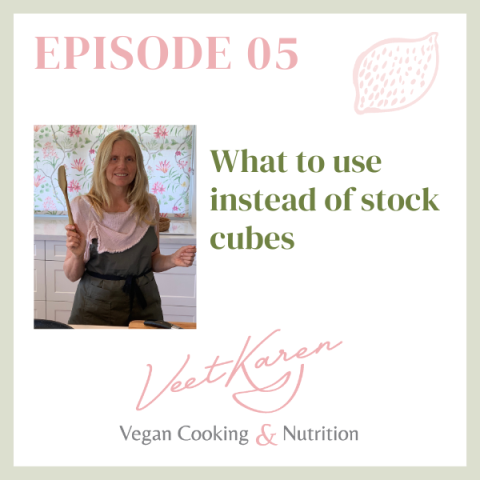
Episode 05
What to use instead of stock cubes
I haven't used stock cubes for decades because they often contain poor-quality ingredients or ingredients that I don't want to cook with.
In this podcast I discuss why I don't use stock cubes and what I do instead.
I cover
Reasons why I don’t use stock cubes
Transitioning to not using stock cubes
Stock can overpower the flavour of the other ingredients
Other alternatives for stock
How to make your own stock
How to have your own stock on hand
Listen Now
Show Notes and Links
https://www.veets.com.au/vegan-chef-training Vegan Chef training, a fabulous immersion into cooking either to create your own business or for your own home use
https://www.veets.com.au/blog/immune-boosting-greek-lentil-soup Greek lentil soup, a must have soup in your freezer at all times
https://www.veets.com.au/vegan-foundation-cooking-course Vegan Foundation Cooking Course is a fabulous start to your plant based journey. It is a hands on experience working with Veet live online
Let me know your thoughts in the comments.
Show notes in full are at www.veets.com.au/1
Follow Veet on https://www.facebook.com/VeetKarenVegancookingandnutrition/
Introduction
When I was growing up, stock cubes were a regular item in the pantry and I did use to wonder why my mum used to use them to make gravy. Sometimes she would even put one in spaghetti Bolognese and I wondered why she was using them.
Didn't the food that she made already taste good without adding the stock cubes?
I don't know if I remember buying stock cubes or if I did I didn't use them all that often.
Reasons why I don’t use stock cubes
I did notice, when I became a chef against palm oil, (I don't use palm oil in any part of my business or life because of the destruction to the rainforest and the devastation to the orangutans in Borneo) that a lot of the stock cubes on the shelves in supermarkets had palm oil in them, so I didn't want to use them for that anymore and as I cooked for a business, there would be all sorts of dietary requirements so using stock cubes just wasn't an option.
Some stock cubes
Contain MSG in them
have onion and garlic and not everybody I used to cook for ate onion and garlic
have preservatives in them
I did dabble with buying good quality stock powders like Marigold that are organic but found they could be expensive, and I learned to cook without them and make food taste delicious.
Transitioning to not using stock cubes
If you did want to try not using stock cubes, you may find the food quite bland without them, so a good lead-in to not using stock cubes is trying an organic herb salt.
Or you can make your own stock, which you can make and freeze. The recipe is below.
Stock can overpower the flavour of the other ingredients
Quite recently, in the vegan chef training, three of the students came together to learn event cake baking and we made this most scrumptious mushroom soup. I didn't use any stock because I just wanted the flavour of the mushrooms. I didn't want the flavour of all the other vegetables in a home made stock or stock cube, so at first the flavours felt quite subtle and maybe you would think, oh it needs a stock cube. But actually when we all sat down to eat the soup it was beyond delicious and the flavour of the mushrooms really came through.
Sometimes I don't want to use stock because of the soup or whatever you're cooking just tasting like the stock you’ve made.
Other alternatives for stock
onion and garlic
celery or celery seeds
herbs that complement what you are cooking. For example; Greek Lentil Soup. It doesn’t need stock as it has oregano, bay leaves and rosemary. That is all the flavouring you need in what you're cooking, so when I make the Greek lentil soup I don't have any stock, I just use salt sometimes, herb salt, but I haven't had herb salt for years.
Occasionally I'll make my own. If I've got left over herbs, I'll dehydrate them, grind them up and put them with some salt and make my own herb salt, but because Greek lentil soup has some incredible herbs in it, I just double up the herb quantity and I get that soup tasting sensational.
So in the Greek lentil soup there's bay leaves and most recipes, including mine, say one bay leaf, so I add two, if it says two tablespoons of oregano I add four and if it says two tablespoons of rosemary I add four.
Oil can also add flavour. If you fry onions, garlic and celery in a splash of olive oil, you get a really bold flavour through your soup or whatever you are cooking.
Here is a recipe for how to make your own stock
What I do is I, collect things throughout the week, so if I know I'm going to need stock I collect
onion skins and garlic skins,
carrot peel and ends
kale stalks
silverbeet stalks
celery, a little bit of celery, I used to use the leaves but I find it goes too bitter.
a couple of mushrooms that are on the older side or sometimes fresh mushrooms
a bay leaf
peppercorns
parsley stalks or stalks of other herbs that go with the dish I am using the stock for
the ends of zucchini, broccoli, cauliflower leaves – all the bits you usually put in the compost.
What I don’t use is
potato peels (too dirty)
pumkin skin (too sweet)
beetroot (too red, make whatever you are cooking red)
Using herbs in a home made stock
If you're wanting a stock for a Southeast Asian dish, use some ginger. You could use the skin of the ginger, you could use some lemongrass, some coriander. I wouldn't put coriander if I was going to be making Italian, like minestrone, so I just keep it in with what's going on with the dish. I would use basil and oregano instead.
If you knew that you were making Borscht for example, which calls for thyme then you could put thyme in with the stock.
Collect all the stock items during the week. Add any veggies from the crisper that are wilting, like carrots for example.
Wash them and cut them into small pieces, this gives the stock more flavour.
Place in a large saucepan and add 2 tsp salt, 11 peppercorns, 2 bay leaves and a big glug of olive oil - up to ¼ cup. Place the lid on the saucepan, put on a low heat and let the veggies sweat for 30 minutes.
Add 1 to 2 litres of water, depending on how much stock you want to make. Bring to the boil then let simmer for an hour.
Place a colander over a large bowl or other saucepan and strain the stock/liquid from the veggies into that saucepan or bowl. Pop the cooked veg in the compost.
You can store the stock in glass jars in the fridge for a week or freeze it for 3 months
Fun Cooking Tip (FCT)
Okay this is a fun cooking tip. What you can do with that stock now is, you can freeze it. You can freeze it in portions, you can freeze it in cubes, you can freeze it however you want and you can use it when you have a recipe calls for it.
What other people do is, they collect their leftover veggies, like the onion peels, garlic peel, the parsley stalks, the celery. All of that that I just talked about, they collect that and put it in freezer, then when they've got enough, they'll make a stock up and cook with that stock. Isn't that great?
If you're wanting to make food taste sensational, the best place to come and work with me is in the Vegan Foundation Cooking Course
The Vegan Foundation Cooking Course is now an online course. It consists of 3 x 3 hours of online cooking with me, just me, yep me, for nine full hours. You'll learn how to make your food taste sensational, be packed with protein and be absolutely wonderful for you to cook, time and time again.
Okay have a great week and I hope you make sensational food.
Would love if you can subscribe, comment and share this podcast.




